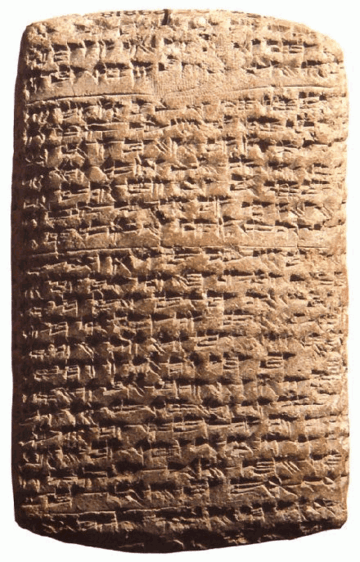Abdi-Heba
Abdi-Heba (Abdi-Kheba, Abdi-Hepat, or Abdi-Hebat) was a local chieftain of Jerusalem during the Amarna period (mid-1330s BC). Abdi-Heba's name can be translated as "servant of Hebat", a Hurrian goddess. Whether Abdi-Heba was himself of Hurrian descent is unknown, as is the relationship between the general populace of pre-Israelite Jerusalem (called, several centuries later, Jebusites in the Bible) and the Hurrians. Egyptian documents have him deny he was a ḫazānu and assert he is a soldier (we'w), the implication being he was the son of a local chief sent to Egypt to receive military training there.[1]
Also unknown is whether he was part of a dynasty that governed Jerusalem or whether he was put on the throne by the Egyptians. Abdi-Heba himself notes that he holds his position not through his parental lineage but by the grace of Pharaoh, but this might be flattery rather than an accurate representation of the situation. At this time the area he administered from his garrison may have had a population of fifteen hundred people and Jerusalem would have been a 'small highlands stronghold' in the fourteenth century BC with no fortifications or large buildings.[2]
Correspondence with Egypt
During Abdi-Heba's reign the region was under attack from marauding bands of Habiru.[3] Abdi-Heba made frequent pleas to the Pharaoh of Egypt (probably Amenhotep III), for an army[4] or, at least, an officer to command.[5] Abdi-Heba also made other requests for military aid in fighting off his enemies, both Canaanite warlords and bands of Apiru:
Say to the king, my lord: Message of Abdi-Heba, your servant. I fall at the feet of my lord 7 times and 7 times. Consider the entire affair. Milkilu and Tagi brought troops into Qiltu against me... ...May the king know (that) all the lands are at peace (with one another), but I am at war. May the king provide for his land. Consider the lands of Gazru, Ašqaluna, and Lakisi. They have given them [my enemies] food, oil and any other requirement. So may the king provide for archers and send the archers against men that commit crimes against the king, my lord. If this year there are archers, then the lands and the hazzanu (client kings) will belong to the king, my lord. But if there are no archers, then the king will have neither lands nor hazzanu. Consider Jerusalem! This neither my father nor my mother gave to me. The strong hand (arm) of the king gave it to me. Consider the deed! This is the deed of Milkilu and the deed of the sons of Lab'ayu, who have given the land of the king to the 'Apiru. Consider, O king, my lord! I am in the right!.... EA 287.[6]
As a result, conspiracy charges are made against Abdi Heba, who defended himself strenuously in his correspondence with Pharaoh.[7]
In later years Abdi-Heba appears to have reconciled with the Apiru, or at least certain bands of them, and hired mercenaries from among their ranks. Indeed, though he earlier complained about the depredations of Labaya, Shuwardata, king of the Canaanite town of Keilah as well as other places in the Judean highlands, refers to him as a "new Labaya":
Say to the king, my lord, my god, my Sun: Message of Shuwardata, your servant, the dirt at your feet. I fall at the feet of the king, my lord, my god, my Sun, 7 times and 7 times. The king, my lord, permitted me to wage war against Qeltu (Keilah). I waged war. It is now at peace with me; my city is restored to me. Why did Abdi-Heba write to the men of Qeltu, "Accept silver and follow me?"... Moreover, Labaya, who used to take our towns, is dead, but now another Labaya is Abdi-Heba, and he seizes our town. So, may the king take cognizance of his servant because of this deed... EA 280.[8]
Abdi-Heba's ultimate fate is unknown.
List of Abdi-Heba's 6 letters to Pharaoh
Abdi-Heba was the author of letters EA 285–290.[9]
References
- Donald B. Redford, Egypt, Canaan, and Israel in Ancient Times, Princeton University Press, 1992 p.270.
- Finkelstein, Israel and Silberman, Neil AsherThe Bible Unearthed: Archaeology's New Vision of Ancient Israel and the Origin of Its Sacred Texts, 2001, The Free Press, New York City, ISBN 0-684-86912-8 p. 239
- EA 179. Scholars refer to the Amarna letters by a number system prefixed with "EA" for "El Amarna".
- EA 179-183.
- EA 182
- William L. Moran, The Amarna Letters, Baltimore: Johns Hopkins University Press, (1992), pp.327-28
- EA 179.
- Moran, op. cit., pp.321-22
- Moran, op. cit., pp.325–334
Resources
Sources
Translations adapted from
- Moran, William (ed. and trans.) The Amarna Letters. Baltimore: Johns Hopkins Univ. Press, 1992.
Other works
- Baikie, James. The Amarna Age: A Study of the Crisis of the Ancient World. University Press of the Pacific, 2004.
- Cohen, Raymond and Raymond Westbrook (eds.). Amarna Diplomacy: The Beginnings of International Relations. Johns Hopkins University Press, 2002.
